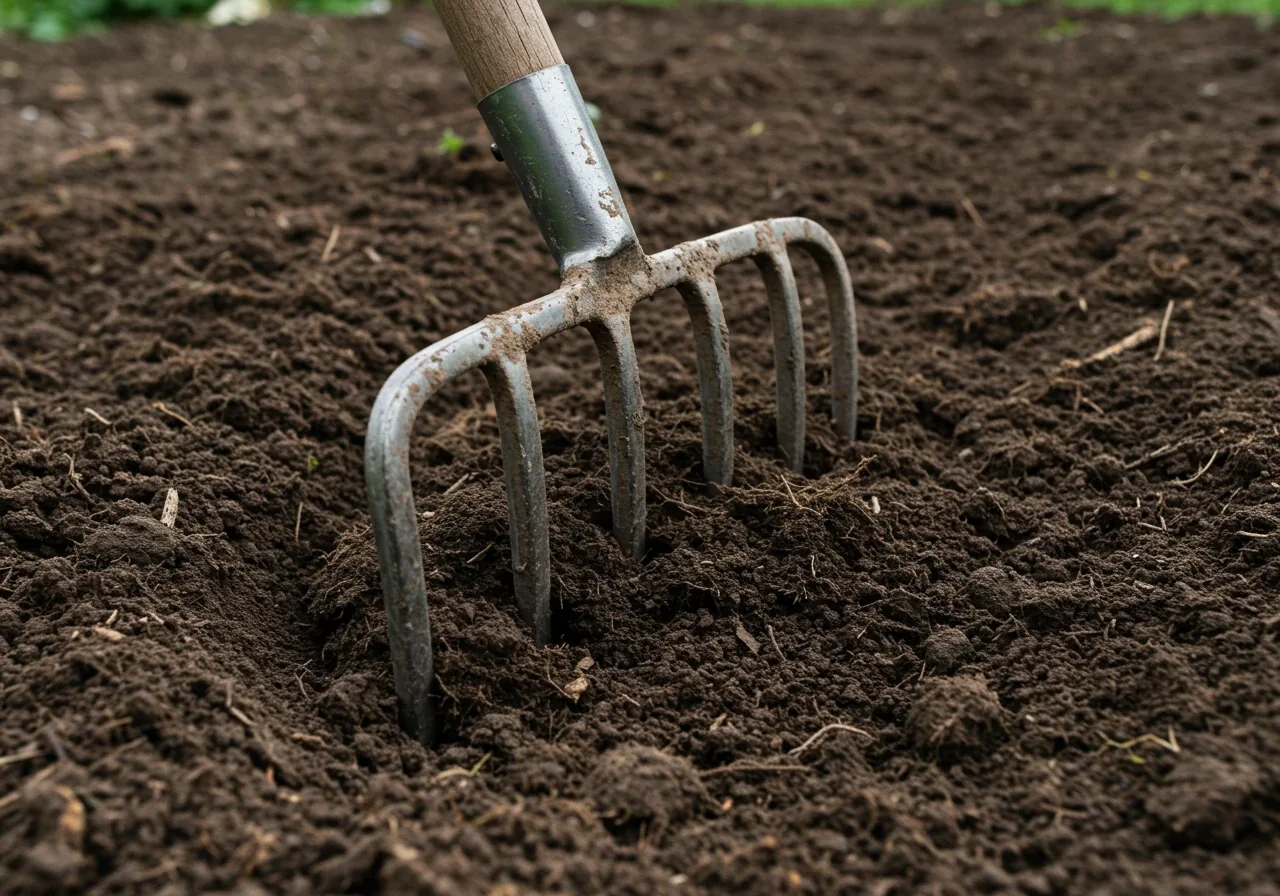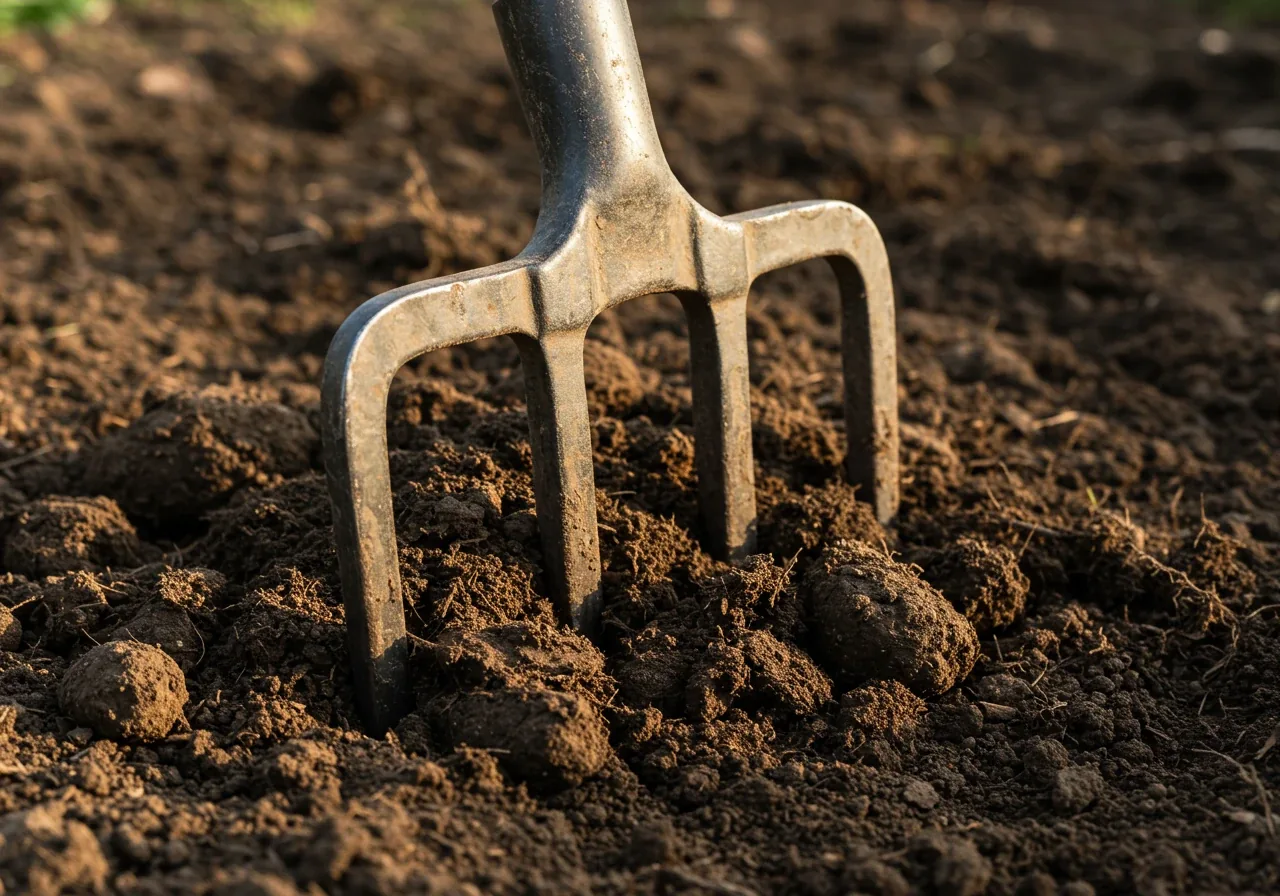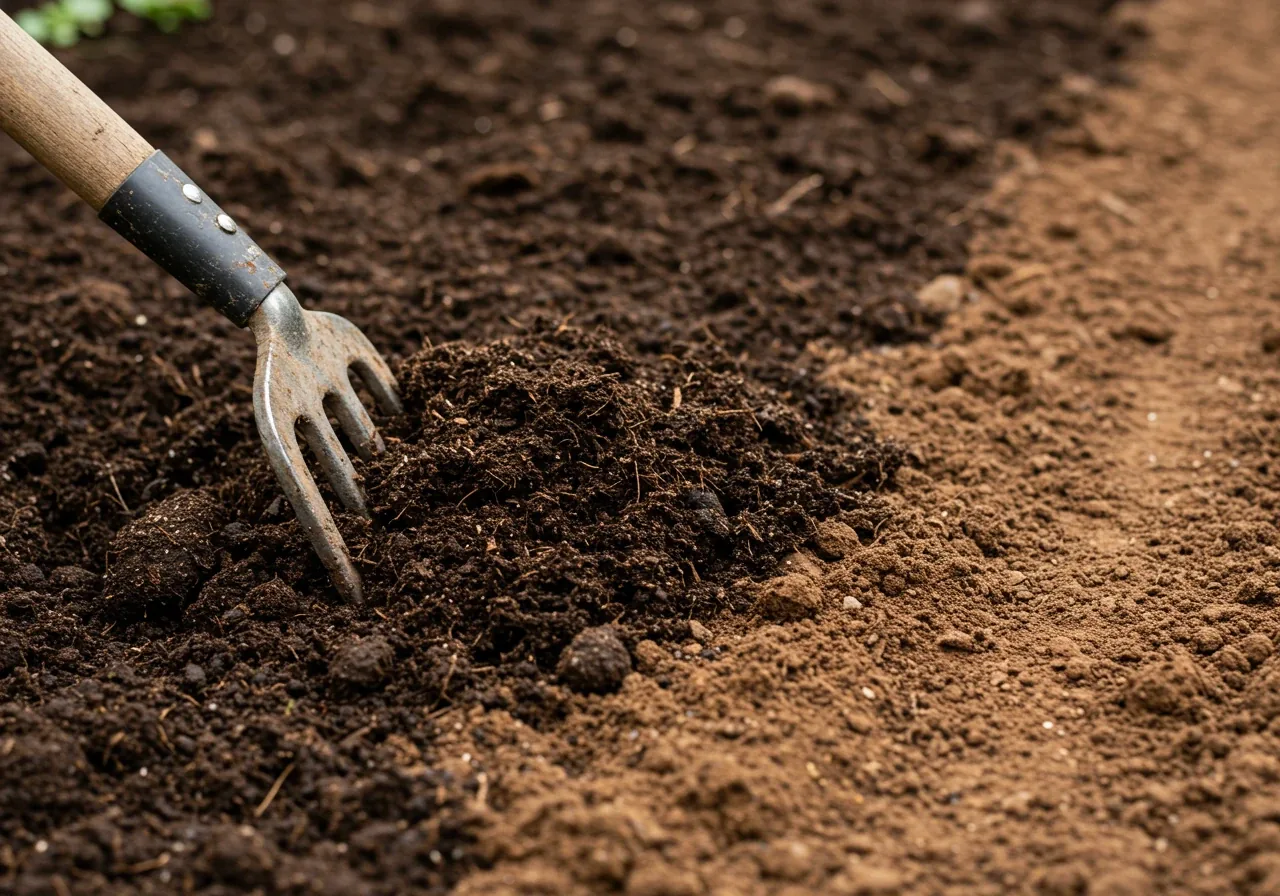Vernon Spring Garden Tools: Easier Digging in Clay Soil
Ready to transform your challenging clay soil garden but need a hand? Request a free quote today and let our experts help make your garden dreams a reality!
Quick Tips for Clay Soil Success:
- Use the Right Tools: Invest in heavy-duty, forged steel spades (pointed) and digging forks.
- Dig When Moist: Avoid digging when clay is very wet (sticky) or very dry (rock hard).
- Amend Generously: Regularly mix compost or other organic matter into your soil.
- Work Smart: Use body weight, leverage tools correctly, and break up clumps with a fork.
- Consider Raised Beds: A good alternative if amending existing soil is too difficult.
Introduction: Greeting Spring (and Ottawa Clay!) in Vernon
Ah, spring in the Ottawa region! The last stubborn patches of snow *finally* surrender, the birdsong returns, and that familiar itch to get out into the garden begins. Whether you're dreaming up ambitious landscaping plans in Vernon or just eager to plant some colourful annuals near Greely, the pull towards digging in the dirt is strong. But then comes the moment of truth. You grab your shovel, full of enthusiasm, take aim at that promising patch of earth, and… *thud*.
Welcome to the often-frustrating reality of Ottawa clay soil! For many gardeners, especially in areas like Vernon, wrestling with this heavy, compacted soil can feel less like therapeutic gardening and more like an archaeological dig. It sticks when wet, turns brick-hard when dry, and can give your back and arms quite the workout. Add in Ottawa's famously unpredictable spring weather – late frosts one week, surprising heat the next – and getting started can feel challenging. Check out local resources like the Master Gardeners of Ottawa-Carleton for planting advice tailored to our climate.
Fear not, fellow earth-turners! This guide is designed specifically for you. We’ll explore the best garden tools that can help you conquer that clay, making your spring soil preparation easier and more effective. Let's find the right gear to turn that digging dread into digging delight!
Clay Soil Confessions: Understanding Your Ottawa Garden Bed

Okay, let's have a little heart-to-heart about the ground beneath our feet here in Ottawa. If you've ever felt like your garden trowel just *bounced* off the soil, or your boots gained ten pounds after a spring rain, you've likely met our region's infamous clay. It's time for some clay soil confessions!
So, what exactly *is* this stuff? Imagine tiny, microscopic rock particles, all flat and sticky. When wet, they cling together like best friends at a muddy music festival, making drainage a real challenge – hello, soggy spring garden beds! When dry, they pack down tighter than sardines in a can, becoming rock-hard and making it tough for plant roots, water, and air to penetrate. You’ll find this characteristically heavy soil throughout the Ottawa area, from bustling Nepean to the growing communities in Barrhaven, and out towards areas serviced by our Metcalf garden clean up service.
But wait, it's not *all* bad news! Clay soil is actually a bit of a nutrient powerhouse. Those tiny particles are great at holding onto essential minerals that plants need to thrive. Unlike sandy soils where nutrients wash away easily, clay hangs onto them. This means, once established, plants can have a steady supply of food. Plus, its ability to retain water can be a secret weapon during dry spells, something discussed in our guide to Vernon Summer Plant Care Secrets.
The main challenges? Drainage and compaction, especially in spring. Water tends to sit on top or drain *very* slowly, which can drown young plants or encourage root rot. And trying to dig compacted clay? It's a workout! Improving this structure over time is key. Thoughtful soil amendment should be part of any long-term garden strategy, perhaps even factored into your initial plans to Avoid Common Landscape Master Plan Errors. Preparing beds properly also supports vigorous growth for things like shrubs, ensuring they respond well if you ever need a Vernon Shrub Renovation Pruning Guide.
Understanding your clay soil is the first step to working *with* it, not against it. Amending it with organic matter, like compost (learn about local options from the City of Ottawa's Green Bin program), is crucial. This helps separate those sticky particles, improving drainage and making it easier to work. Tackling soil improvement is often a good task for the autumn, complementing your Vernon Fall Cleanup and Ottawa Winter Prep. Don't feel overwhelmed; improving heavy clay is a marathon, not a sprint, and if you need help transforming your garden beds, exploring professional Clean Yards Landscaping Services is always an option. Knowing your soil’s personality is half the battle won!
Common Clay Soil Problems
- Poor Drainage: Water sits on top, leading to soggy roots.
- Compaction: Soil gets rock-hard when dry, restricting root growth and water penetration.
- Difficult to Work: Heavy and sticky when wet, tough to dig when dry.
- Slow Spring Warm-up: Dense, wet soil takes longer to warm up.
These challenges often require specific tools and techniques, and sometimes professional help like our Ottawa yard cleanup service for initial heavy work.
The Upside of Clay Soil
- Nutrient Retention: Clay particles hold onto essential plant nutrients very well.
- Water Retention: Can be beneficial during dry periods, holding moisture longer than sandy soils.
- Good Foundation: Provides firm anchorage for larger plants and shrubs.
Learning to manage clay can lead to a very fertile garden. Find inspiration in our project transformations!
Tips for Improving Clay Soil
- Add Organic Matter: Compost, aged manure, shredded leaves are key. Add annually.
- Avoid Compaction: Don't walk on wet soil. Use paths or boards.
- Mulch Regularly: Mulching helps regulate moisture and temperature, and adds organic matter as it breaks down.
- Use Cover Crops: Planting cover crops like rye or clover in the off-season can improve structure.
- Consider Gypsum (Use Judiciously): Sometimes recommended, but test soil first. Organic matter is usually better.
Consistent garden maintenance focusing on soil health is crucial.
Tool Throwdown: Why Your Average Shovel Cries in Clay

Alright, let's talk tools. You've got your gardening gloves, maybe a jaunty hat, and you march out to face that patch of Ottawa clay, shovel in hand. Five minutes later, are you admiring your progress, or is your shovel handle bent at a funny angle, the blade looking suspiciously warped, and your back already complaining? If it's the latter, you've discovered a fundamental truth: not all digging tools are created equal, especially when facing the heavy, compacted soil common around here, from Metcalfe to the edges of the city. Tackling tough jobs might require our city yard cleanup service.
Your average, lightweight garden shovel or spade, often bought cheaply from a big box store, is designed for loose loam or sandy soil. It's like bringing a butter knife to a steak fight when you tackle dense clay. Here’s where things go wrong:
- Handles: Wooden handles, especially those with less dense grain or thinner diameters, will flex under pressure and eventually snap, often right where they join the blade socket – the weakest point. Cheap metal or plastic handles? Forget about it. They’ll bend or crack faster than you can say "uh oh."
- Blades/Tines: Stamped metal blades (thin metal pressed into shape) will bend, buckle, or even break off at the tip when you try to lever out a heavy clump of clay. Fork tines will bend outwards, resembling a sad, splayed hand.
- Connections: The socket where the handle meets the blade is crucial. On cheaper tools, this is often just spot-welded or weakly riveted, providing a prime failure point under the intense leverage needed for clay digging.
Using the wrong tool isn't just frustrating; it's inefficient and can even lead to strained muscles or back injuries. Investing in the *right* tools specifically designed for heavy soils is essential for successful gardening and landscaping in clay-rich areas. Think of it as choosing the right gear for the job – you wouldn't wear flip-flops to go hiking, right? Tackling tough soil might even make you consider getting help; many comprehensive Clean Yards Landscaping Services factor soil type into their approach. Information about local suppliers can sometimes be found via the Ottawa Horticultural Society.
Let's compare the contenders:
| Feature | Standard Spade/Fork | Heavy-Duty (Clay) Spade/Fork | Why it Matters for Clay |
|---|---|---|---|
| Blade/Tine Material | Thinner, stamped metal; sometimes aluminum | Thicker, forged steel; often heat-treated | Resists bending, breaking, and dulling under pressure. |
| Handle Material | Softwood, thin metal, plastic | Hardwood (Ash), Fibreglass, Solid Steel | Provides strength and rigidity needed for prying leverage. |
| Socket/Tang | Short socket, often welded or riveted | Long socket, often solid-forged or strongly riveted/bolted | Creates a much stronger connection, preventing breakage. |
| Design | Often wider, flatter blade; lighter tines | Often narrower, pointed blade; thicker, stronger tines | Better penetration into dense soil; less surface area means less resistance. |
| Effectiveness | Bends, breaks, causes frustration | Cuts through clay, less effort, lasts longer | Makes digging feasible and less physically demanding. |
Using the right shovel or fork transforms clay digging from a dreaded chore into a manageable task. A sturdy border fork (with flat, stronger tines) or a pointed drain spade can be particularly effective. Remember, good tools make lighter work, saving your back and your sanity. If the sheer volume of digging or soil amendment feels overwhelming, especially for larger areas, professional help like a dedicated Vernon Yard Cleanup Service or a specific Metcalf Garden Clean Up Service can be invaluable. They have the tools and expertise. Sometimes, tackling stubborn ground is part of a bigger picture, like when needing a full Metcalf Property Cleanup Service to get things under control. Whether you're in a suburban neighbourhood or need a broader City Yard Cleanup Service, having the right equipment, whether yours or a pro's, is key to conquering Ottawa clay.
Meet the Clay Slayers: Essential Spring Digging Tools
Okay, so we know standard tools often surrender when faced with Ottawa's notorious clay. Don't despair! It's time to meet the *real* heroes of spring digging – the tools built tough enough to tackle that stubborn soil. Think of them as your personal Clay Slayers! Equipping yourself correctly means less sweat, less frustration, and more enjoyable time preparing your garden beds, whether you're landscaping in Manotick or planting veggies in Osgoode.


Here are the essential heavy-duty heroes for your spring arsenal:
The Pointed Powerhouse: The Heavy-Duty Spade
Forget wide, flimsy shovels. For clay, you want a *spade* – specifically one built like a tank. Look for a forged steel blade (not stamped metal!), preferably with a pointed tip or a slightly narrower profile (like a drain spade). This shape helps penetrate dense clay more easily than a flat edge. The handle should be robust – solid hardwood (like Ash), fibreglass, or even steel are best. Critically, check the connection between handle and blade – a long socket or a solid steel shaft running well up the handle (a solid socket or tang) means it won't snap when you inevitably need to pry up a heavy clump.How to Use: Place the pointed tip where you want to dig, put your foot on the turned step at the top of the blade (if it has one), and use your body weight to push it down. Wiggle it slightly to break the soil's grip. Use it for slicing through compacted soil, digging planting holes, and creating clean edges for new garden beds.
The Clump Crusher: The Digging Fork (or Border Fork)
Not to be confused with a lightweight pitchfork for hay! A *digging fork* (sometimes called a garden fork or spading fork) is your best friend for breaking up clods of clay turned over by your spade. Look for thick, strong tines – ideally square or flattened (like on a border fork), not thin round ones that bend easily. Forged steel is again the material of choice. A strong handle and socket are just as important here as on the spade.How to Use: Plunge the tines into the turned soil or directly into compacted ground. Rock the handle back and forth to loosen the soil. It’s excellent for breaking up large clumps, incorporating compost or amendments, and aerating the soil without completely pulverizing its structure. It's less effort than lifting solid shovelfuls of heavy clay. Tackling large areas this way can still be taxing; if you're facing a major soil overhaul as part of a larger project, like those needing a full Metcalf Property Cleanup Service, specialized equipment might be better.
The Deep Loosener: The Broadfork
This might look a bit medieval, but it's a back-saver! A broadfork has multiple long, strong tines attached to a horizontal bar with two upright handles. You stand on the bar to drive the tines deep into the soil, then use your body weight, rocking back on the handles, to lever the soil upwards, loosening it deeply without inverting the soil layers. This preserves soil structure and minimizes disturbance to soil life.How to Use: Position the fork, step onto the crossbar driving the tines down, step off, and pull back on the handles. Move backward, repeating the process. It's fantastic for aerating compacted beds across larger areas before planting. Your back will definitely send you a mental thank you note after using this instead of just a spade for big jobs!
The Toughest Customers: Mattock & Auger (Brief Mentions)
For truly stubborn, rocky, or root-filled clay, especially when breaking new ground in areas like Richmond or dealing with severely neglected spots, a *mattock* (with its pick/adze combination) can be invaluable for chopping and prying. For planting multiple shrubs or posts, a *handheld or powered auger* drills precise holes, saving immense effort. These are more specialized, but worth knowing about for the toughest challenges. Sometimes, these heavy-duty tasks are best left to professionals who handle challenging terrain as part of a comprehensive City Property Cleanup Service. You can learn more about us and the types of equipment we use for such jobs.
Buying Tip: Invest in quality. Look for forged steel heads, strong handles (fibreglass or hardwood), and solid connections. Good tools cost more upfront but last *much* longer and make gardening in clay significantly easier and safer. If preparing multiple beds or dealing with very compacted soil feels overwhelming, remember that an Ottawa Garden Clean Up Service can handle the heavy digging, getting your beds ready for planting season. Choose the right tool, and you'll be slaying that clay in no time!
Digging Effort Comparison (Estimated)
Relative effort required for digging a standard garden bed (lower is better):
Digging Deeper (Without Breaking Your Back): Techniques for Clay

Okay, let's face it, digging in heavy Ottawa clay can feel like trying to chisel granite with a spoon sometimes. But before you throw your shovel down in despair (or actually *break* your back), know this: *how* and *when* you dig makes a world of difference. With the right approach, you can work smarter, not harder.
First things first: *timing is everything*, especially with clay. Remember Goldilocks? You want soil moisture that's "just right." Digging when it's soaking wet after a heavy Ottawa spring rain creates a sticky, compacted mess. Trying to dig when it's bone-dry and baked hard (hello, concrete!) is an exercise in futility and potential tool destruction. The sweet spot is usually a day or two after a decent rain, when the soil is moist enough to crumble but not so wet that it sticks excessively to your tools. Gently squeeze a handful – if it forms a sticky ball, wait. If it crumbles nicely, it’s go time! Community gardening groups like Just Food Ottawa often share tips on working with local soil conditions.
Now, let's talk technique:
- Spade & Fork Combo:
- Don't try to conquer the whole garden at once. Work in small, manageable sections.
- Use your *body weight*, not just your arms. Place your spade, step firmly on the blade edge, and push down.
- Wiggle the handle gently to loosen the soil's grip before trying to lift. Avoid prying too hard with just the spade – that's how handles snap!
- Once you've sliced and slightly lifted a section, use your sturdy digging fork. Plunge the tines into the clump and rock the fork back and forth to break it apart. This is much easier than lifting heavy, solid shovelfuls.
- Using a Broadfork:
- Position the broadfork where you want to loosen the soil.
- Step firmly onto the crossbar, using your weight to drive the tines deep into the ground.
- Step off the bar, then pull back on the handles, using leverage to gently lift and aerate the soil below. You don't need to fully turn it over.
- Step backward and repeat, working your way across the bed. It’s fantastic for deep aeration with less strain.
While these techniques help *manage* clay, the *real* long-term fix is improving its structure. Regularly incorporating generous amounts of organic matter – think compost, well-rotted manure, or shredded leaves – is crucial. This gradually separates those sticky clay particles, improving drainage and making the soil much easier to work year after year. Think of it as a core part of your ongoing long-term garden maintenance. If amending a large area feels daunting, getting professional help for the initial soil conditioning, perhaps as part of a wider property clean up, can set you up for success.
Seasonally, spring and fall are the best times for heavy digging and amending in the Ottawa region. Avoid the worst of summer's heat and dryness. Keep in mind that areas slightly further out, like Richmond or Winchester, might thaw or dry out at slightly different rates than central Ottawa, so always test your soil moisture first. Tackling severely compacted areas might even warrant calling in an Ottawa Garden Clean Up Service or even a full Ottawa property cleanup service if it's part of reclaiming a neglected yard. For general garden readiness across town, a city garden clean up service can also handle this tough initial work. Dig smart, amend generously, and your back will thank you!
Timeline: Improving Clay Soil Over Seasons
Early Spring
Test soil moisture. Once workable (moist, not wet), use a heavy-duty spade and digging fork or broadfork to loosen compacted areas. Avoid overworking wet soil.
Mid-Late Spring
Incorporate 2-4 inches of compost or well-rotted manure into the top 6-8 inches of soil before planting. Consider our garden installation services if starting new beds.
Summer
Apply organic mulch (mulching and edging help retain moisture). Water deeply but less frequently. Avoid walking on beds to prevent re-compaction, especially when wet.
Fall
Ideal time for major amendments. Add more compost, shredded leaves, or plant a cover crop. Perform a fall cleanup.
Winter
Let the soil rest. Freeze-thaw cycles can help break up clay naturally. Protect soil from erosion with mulch or cover crops.
Tool TLC: Keeping Your Clay Warriors Fighting Fit
So, you’ve invested in some heavy-duty tools to battle that infamous Ottawa clay. High five! But even the toughest Clay Slayers need a little TLC to stay in fighting shape. Neglect them, and you'll find yourself wrestling rusty, dull, or broken gear next spring. Let’s keep your warriors ready for action!
Think of tool maintenance as your post-battle routine. After tangling with sticky clay, especially in damper spots around Manotick:
- Clean Up Camp: Don't let clay dry and harden on your tools! Scrape off excess soil immediately with a putty knife or stiff brush. A quick rinse with the hose helps too. Caked-on clay is surprisingly stubborn.
- Banish the Rust Monster: Ottawa's humidity loves to turn shiny steel into rusty relics. Dry your tools *thoroughly* after cleaning. Wipe metal parts with an oily rag – boiled linseed oil works great, but even WD-40 helps displace moisture and prevent rust. Clean tools are crucial for effective soil preparation for Ottawa gardens.
- Keep 'Em Keen: A sharp spade or fork cuts through clay much more easily, saving your energy. Use a mill bastard file or a grinder (carefully!) to restore the bevelled edge on spades and hoes. Sharp tools make any job faster, something the pros performing an Ottawa yard cleanup service know well.
- Handle With Care: Check wooden handles for splinters or cracks. Sand them smooth occasionally and apply linseed oil to prevent drying and cracking. Inspect fibreglass or metal handles for damage too. A broken handle mid-dig is no fun!
- Store Smart: Don't just lean your tools against the garage wall. Hang them up in a dry shed or garage. This keeps them off damp floors, prevents clutter, and protects edges. Good tool care ensures efficiency, whether you're doing DIY landscaping or hiring a city garden clean up service.
Spending a few minutes on care after each use extends the life of your tools dramatically, saving you money and making your next gardening session much less frustrating. Weighing the investment in quality tools and maintenance time against professional help? We get it - budgeting is key, much like when you review an estimate or provide feedback. If you ever have questions about tool care or need help tackling a big job, feel free to contact us. Happy digging!
Vernon Gardener's Cheat Sheet for Clay
Hey neighbours in Vernon, Kars, Kenmore, and beyond! Wrestling with that stubborn Ottawa clay? You're not alone! It can feel like gardening in cement sometimes, but don't hang up your trowel just yet. Here’s a quick cheat sheet to make peace with your heavy soil:
- Time Your Dig Just Right: Forget wrestling sticky goo or rock-hard earth. Dig when clay is *moist but not wet* – usually a day or two after rain. Squeeze a handful; if it crumbles nicely, grab your tools. If it’s slimy, grab a coffee and wait!
- Gear Up Like a Pro: Ditch flimsy tools! Invest in a heavy-duty, pointed *spade* and a strong *digging fork* (border forks are great!) with forged steel heads and solid handles (fibreglass or hardwood). These powerhouses make slicing and breaking up clay much easier.
- Amend, Amend, Amend!: Clay needs organic matter like teenagers need snacks – constantly! Mix in heaps of compost, aged manure, or shredded leaves every chance you get (spring and fall are ideal). This improves drainage and workability over time. Choosing the right stuff is key; check out some tips on garden material selection guidance.
- Work Smarter, Not Harder: Use your *body weight* on the spade, not just your arms. Wiggle the tool to loosen soil. Use the fork to break up clumps turned over by the spade – it's less strain than lifting solid clay shovelfuls. Tackling a huge, compacted area? Sometimes calling in the cavalry makes sense – services like a Metcalf yard cleanup service or even a broader Marionville property cleanup service have the equipment for tough jobs. You can always get a quote and share your thoughts via our estimate and feedback form to see if it fits your plan.
- Be Patient & Persistent: Improving clay soil is a marathon, not a sprint. Keep adding organic matter and using good techniques. Consistent effort is part of good landscaping practice and can be factored into ongoing city garden maintenance service plans, ensuring your garden gets better year after year.
Stick with it! Working *with* your clay, not just against it, is the secret to a thriving Ottawa garden. Happy digging!
FAQs: Your Ottawa Clay Soil Questions Answered
Ah, the classic Ottawa clay conundrum! The best long-term solution is consistently adding *organic matter*. Think compost, well-rotted manure, shredded leaves – mix generous amounts into the top few inches each spring and fall. This gradually improves drainage (less goo!) and prevents that rock-hard summer bake. It’s a marathon, not a sprint, but totally worth it! Our Google Business Profile often features tips and reviews from local gardeners facing similar challenges.
Great question! Instead of fighting the clay, choose plants that tolerate it. Many gorgeous perennials thrive here: Daylilies, Hostas, Coneflowers (Echinacea), Black-Eyed Susans (Rudbeckia), Peonies, and sturdy ornamental grasses do well. For shrubs, look at Dogwood, Viburnum, Potentilla, and Spirea. Choosing wisely makes gardening much more rewarding! Consider robust options for lawn care areas adjacent to clay beds too.
Raised beds are definitely a popular workaround! They let you start fresh with great soil, bypassing heavy digging. However, improving your *existing* soil with amendments benefits the wider ecosystem of your yard and helps plants with deeper roots. You could even do both! If setting up beds seems like a big task, you can always get help with garden install to get started quickly. Also think about related services like sod installation if you're overhauling the whole area.
You want the "Goldilocks" moment – not too wet, not too dry! The ideal times are usually spring (after thaw, before intense heat) and fall (after summer dryness, before freeze-up). Wait a day or two after a good rain when the soil is moist enough to crumble but doesn't stick horribly to your tools. Avoid digging when it's waterlogged or bone dry. Check our Privacy Policy and Terms and Conditions if you're engaging our services for seasonal work.
Absolutely! Transforming heavy clay, especially over a large area or for a new garden project, is hard work. Don't feel bad about calling in reinforcements! Professional services often tackle tough soil prep. For instance, a Metcalf yard cleanup service can handle challenging ground, and options like a specialized Marionville garden clean up service or a comprehensive Marionville yard cleanup service exist exactly for these kinds of bigger jobs. Getting help can save your back and kickstart your project.
Conclusion: Conquer the Clay and Cultivate Your Dream Garden
So there you have it! Gardening in Ottawa's infamous clay soil, whether you're in Vernon, Embrun, or out near Winchester, doesn't have to feel like a losing battle. It definitely has its quirks – demanding, sticky when wet, hard as nails when dry – but it's not invincible. Remember, the secret weapons are choosing the *right* heavy-duty tools (your mighty Clay Slayers!), using smart digging techniques that save your back, and consistently showing your soil some love with plenty of organic matter like compost.
It might take a little extra effort initially, but transforming that tricky clay into a thriving garden bed *is* achievable. Don't let the ground get you down! Embrace the challenge, gear up properly, and watch your dream garden take root. You’ve got this!
Ready to turn that clay patch into paradise?
- Need personalized advice for your specific yard or want professional help tackling the tough stuff? Contact Clean Yards today – we’re happy to chat about your landscaping and gardening goals!
- Want more tips? Check out our other posts on soil preparation or explore our garden bed installation services.
- Got your own clay-conquering stories or tips? Feel free to share via our feedback form – we love hearing from fellow Ottawa gardeners!

